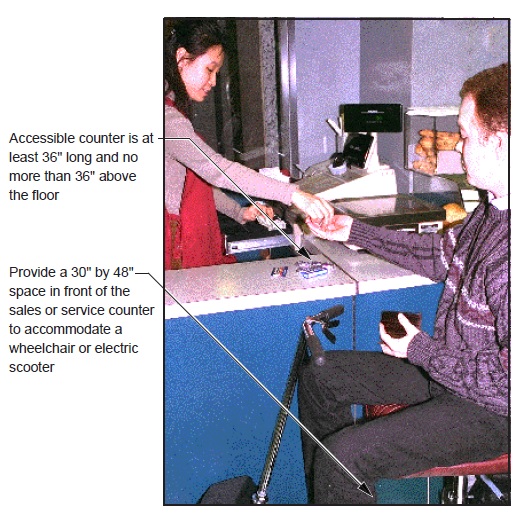Sales and Service Counters
When sales or service counters are provided, the counters must be accessible, if doing so is readily achievable. This access is an important part of receiving the goods and services provided by a business.
At counters having a cash register, a section of counter at least 36 inches long and not more than 36 inches above the floor will make the counter accessible. This provides a lowered surface where goods and services and money can be exchanged. An alternative solution is to provide an auxiliary counter nearby.

An accessible sales counter at a cash register
Notes on photo:
- Accessible counter is at least 36" long and no more than 36" above the floor
- Provide a 30" by 48" space in front of the sales or service counter to accommodate a wheelchair or electric scooter
At sales and service counters, such as ticketing counters, teller stations in a bank, registration counters in hotels and motels, and other counters where goods or services are sold or distributed a counter that is at least 36 inches long and that is not more than 36 inches above the floor will make the counter accessible. It is also possible to provide an auxiliary counter nearby or to use a folding shelf or area next to the counter, if doing so is readily achievable.
In addition to having a maximum height of 36 inches, all accessible sales and service counters must have a clear floor space in front of the accessible surface that permits a customer using a wheelchair to pull alongside. This space is at least 30 inches by 48 inches and may be parallel or perpendicular to the counter. It is also connected to the accessible route which connects to the accessible entrance and other areas in the business where merchandise or services are provided.
If you cannot provide an accessible sales or service counter or auxiliary counter nearby, such as a table or desk, you may provide a clip board or lap board for use until a more permanent solution can be implemented.
Checkout aisles, such as in a grocery store, have different requirements. An accessible checkout aisle should provide a minimum of a 36-inch-wide access aisle and it should be identified by a sign with the international symbol of accessibility mounted over the aisle. The counter adjacent to the accessible checkout aisle has a maximum height of 38 inches. If a lip is provided between the counter and the checkout aisle, its maximum height is 40 inches.
The number of accessible aisles that is needed depends on the total number of checkout aisles provided. For example, if one to four aisles are provided, then at least one should be accessible. If more than five to eight aisles are provided, then two accessible aisles are needed. Each type of checkout, including express lanes, must have an accessible checkout aisle.
The ADA Standards for Accessible Design provide detailed information on the requirements for checkout aisles and for sales and service counters.

User Comments/Questions
Add Comment/Question